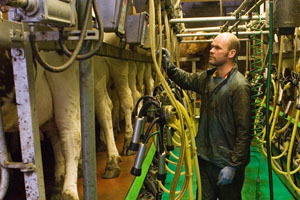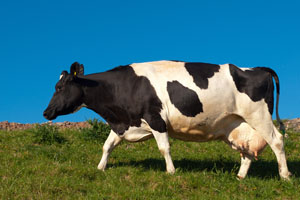Breeding the future dairy cow
Published on 8 July 2011 in Sustainability and Communities
Research by SRUC (formerly SAC) has led to the national adoption of new breeding goals for dairy cattle that improves the health, welfare and economic performance of livestock in the UK and beyond. The aggregate benefits of genetic improvement in the UK dairy industry are estimated to have been between £2.2 billion and £2.4 billion since 1980. The research will also have wider international benefits through the dissemination of genetic improvement from UK bred animals.

Key Challenges
Breeding and selection for improved livestock performance is a complex, expensive and slow process. Meeting the needs of consumers for high quality, affordable dairy products meant that historically dairy breeding goals focused only on high milk output. However, more recently the dairy industry has had to respond to new demands on farming systems including improved production efficiency, reduced greenhouse gas emissions and improved animal health and welfare standards. This has required a continued revision of the aims for dairy breeding programmes in the UK. The economic survival of the industry and supplies of home-produced dairy products are paramount to Scottish livelihoods.
Key Benefits
The research has delivered information on the optimal design of breeding schemes and produced practical selection tools. These have helped dairy producers in the UK to become more sustainable by adapting to a range of challenges, including consumer concerns, breeding for improved economic performance, improved product quality, improved animal health and welfare, and reduced environmental impact.
New selection tools arising from SRUC cattle breeding research are being used to improve selection for the financial or economic values of animal production, longevity, fertility, health and other characteristics.
New selection tools arising from the research are being used in national genetic evaluation programmes for dairy cattle in the UK. New indexes have been introduced since 1995 to improve selection for the financial or economic values of animal production, longevity, fertility, health and other characteristics. Such novel selection practices cumulatively reduce greenhouse gas emissions per breeding animal by 1.4% per annum in dairy systems. The aggregated economic benefits of genetic improvement that has taken place in the years 1980-2009 is estimated to have been between £2.2 billion and £2.4 billion (using a 7% discount rate). This will also have wider international benefits through the dissemination of genetic improvement from UK bred animals.
We have also promoted uptake directly via the provision of key enabling services. Genetic evaluation – the process of predicting the genetic merit of animals from pedigree and performance data (milk yield, growth, disease incidence etc.) and, recently, molecular genetic data – is a mathematically complex, internationally scarce, but key enabling tool in livestock genetic improvement. Edinburgh Genetic Evaluation Services (EGENES) was established in 2005 by SRUC, in association with the University of Edinburgh, to provide livestock genetic evaluation and data handling services, and to help accelerate the transfer of research results into industry practice. EGENES has been contracted by key industry levy boards to provide genetic evaluations for all UK recorded dairy cattle since 2005.


Comments or Questions
Related Websites
Our Partners
DairyCo, National Milk Records, Cattle Information Services, University of Edinburgh, Nottingham University, Genus, Cogent, Holstein UK, Dartington Cattle Breeding Trust, RSPCA, Scottish Government, Defra.
Find Out More
For more information contact Dr Eileen Wall, Eileen.Wall@sruc.ac.ukAuthor
Eileen Wall Eileen.Wall@sruc.ac.uk





